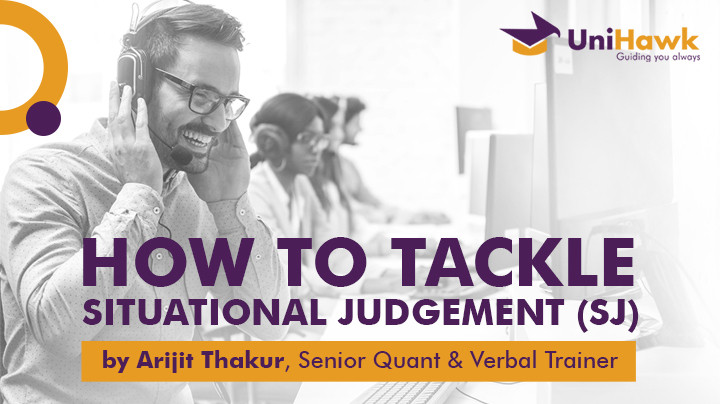The “situational judgement” section features 69 questions which you have to answer within 26 minutes. The vast majority of these questions come in sets of 5 each. Each set pertains to a situation that is described in a paragraph of about 150 words. In each situation, a junior doctor or a medical student has to make a decision about how he or she should react to the actions or words of someone else.
That other person can be a senior doctor, a patient, a patient’s legal guardian or family or friends, a fellow medical student, a fellow junior doctor, a member of the nursing or technical staff at the institution, a non-technical member of the staff like the receptionist, or the “general public” which, in SJ terminology, covers everyone outside the medical community. The decision may also be focused on an environmental factor – instead of a human being. For example, a junior doctor may have to make a decision on what to do with a broken window in a given situation.
Whether the decision is right depends on certain factors. Many of these factors exert an influence in all kinds of situations. However, what the decision should be primarily based on varies from one situation to another. This happens because whom the junior doctor or the medical student is dealing with is of great bearing. For example, a junior doctor must be absolutely transparent when dealing with a patient or a patient’s legal guardian. However, transparency is not that important when dealing with the general public. In fact, the right decision might even be to lie to members of the general public. For example, a doctor may tell you that he does not know the lady who has just smiled at him – though he knows perfectly who she is – because he does not want to disclose the fact that she is one of his patients. This kind of lying is considered the right thing to do – in the world of SJ questions – because a doctor should not ‘out’ his patients to the public.
Besides whom the junior doctor or the medical student is dealing with, an aspect of the situation itself is supposed to influence the decision greatly. In other words, decisions on the same issue may vary greatly from an urgent situation to a non-urgent situation. An urgent situation is one wherein the doctors do not have time to take the ideal path. In such cases, the best available takes precedence over the best possible.
The questions featured in this section are broadly of two types – based on what the examinee is required to identify. In some questions, the decision itself is described in the question and the examinee has to select one of the 4 tags – very appropriate, appropriate but not ideal, inappropriate but not awful, and very inappropriate – to describe the decision. In oher questions, a factor that may influence the decision is described in the question and the examinee has to select one of the 4 tags – very important, important, of minor importance, and not important at all – to describe how far the factor should influence the decision.
Like most other questions in the UCAT, these questions also create a scope for the examinees to delude themselves. The delusion occurs because the answer options are linguistically so adjacent that the reasons to select one seems to justify selecting another as well. The biggest problem is distinguishing between the 2 choices in the middle – appropriate but not ideal, and inappropriate but not awful; important, and of minor importance.
The best way to overcome this problem is to define each of the 4 options in a comparative manner. Indeed, the best and the worst tags should be given to the best and the worst cases. The second best one should be given to something that is good but not as good as the best case you can imagine in 5 seconds. Similarly, the third option from the top should be given to something that is bad but better than the worst you can imagine in 5 seconds.
You should not spend more than 25 seconds on any independent question and more than 2 minutes on any set of 5 questions. Pondering longer does not take you any closer to a sense of certainty that you got the right answer. The reason is simple: a bit of subjectivity creeps into these questions at either end; neither the person who produces an SJ question nor the person who tries to answer that question can be totally objective because the situation the question is based on can appear different from different angles.
Therefore, it makes much more sense to read up all the situation paragraphs in a hurry and answer no question totally blindly. In fact, if you can answer about 2 in every 3 questions correctly, you are almost assured of a band 2 score. If partial marking is allowed, and you have 46 fully correct out of 69 and some others partially correct, then you can get band 1 with 46 fully correct. However, we cannot take partial marking for granted. The UCAT consortium may or may not allow partial marking in the upcoming season.
Since partial marking can play so significant a role, it makes sense to understand its mechanism. Traditionally, UCAT authorities have marked a wrong answer partially correct if it were adjacent to the right answer. In other words, if the third option is the right answer and you marked the fourth option, you are given some credit.
Finally, getting band 2 and getting band 1 are basically the same thing from the admission point of view. A score of 4 automatically disqualifies you for many universities. A score of 3 keeps your chances tentative for most. However, a score of 1 is not distinguished from a score of 2 unless you are absolutely tied on all other parameters with another candidate. That rarely occurs.
by Arijit Thakur, Senior Quant & Verbal Trainer





